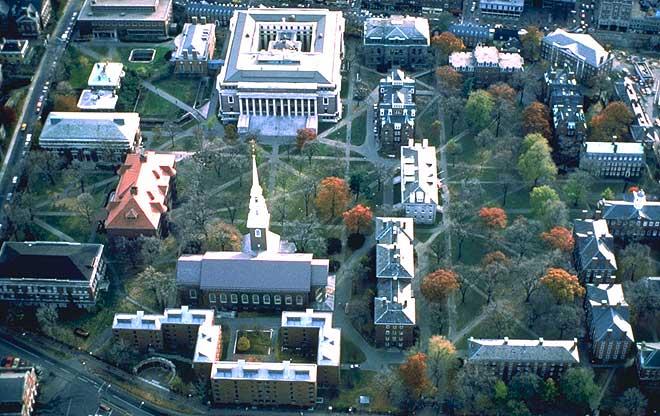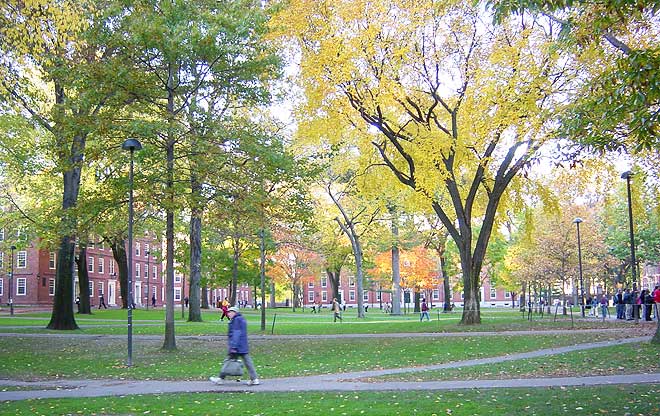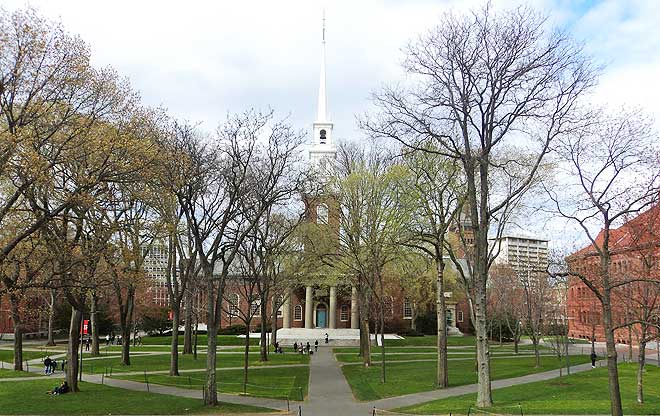
Aerial View
Harvard Yard is one of the oldest continuously used built landscapes in the United States and stands as an icon of American college campuses. Harvard Yard is actually made up of two major spaces: the Old Yard (above, right) and the Tercentenary Theater (left, framed by Memorial Church and Widener Library).
Image: Harvard Archives
Olmsted's Elms
The magnificent American elm trees, planted by the famed Olmsted Brothers landscape architectural firm in the early 20th century, have all but disappeared from the Old Yard, victims of Dutch elm disease. These elms gave a distinct identity to the Yard—a magnificent treed cathedral—one endures as the image of this iconic landscape.
Image: Harvard Archives
Planting an Elm
Undated photo of American elms being installed in the Old Yard.
Image: Harvard Archives
Diversification
The Yard began modestly in approximately 1638 as an acre plot of farm; the land is still extant on the south end of the Old Yard, west of Thayer, University, and Weld Halls. These simple beginnings remain the touchstone for the Old Yard landscape, characterized by a simple palette of lawns and trees. In 1993 and continuing until today, the Yard was replanted with a more diverse canopy to preclude the disease that befell the elm monoculture.
Image: MVVA
The Chairs
In 2009, “The Chairs” project was initiated as a byproduct of the larger “Social Spaces Study,” aimed at making Harvard’s indoor and outdoor spaces more inviting, comfortable, and lively. Every spring, a few hundred of these brightly colored chairs appear in the Old Yard, instantly transforming this historic place into a contemporary haven.
Image: MVVA
New England Autumn
At 25-acres, Harvard Yard is one of the few places in Harvard Square that has a canopy dense enough to experience the full range of New England fall color. This is largely due to the diversity of species that were introduced when the Yard was renovated in 1993. Oak, maple, hackberry, sourwood, plus others make for a bright and long-lasting slide into winter.
Image: MVVA
The New Yard
Tercentenary Theater, the New Yard, was established in 1936 in honor of Harvard’s 300th anniversary. Unlike the Old Yard, where path layout evolved with traffic patterns, the New Yard has paths that form a central axis between the church and library, which were erected when the New Yard was dedicated.
Image: MVVA
Cross Paths
All the paths in the Tercentenary Theater cross the central path, creating wide swaths of pavement at these intersections that become casual places to stop and chat. Although the paving layout is somewhat rigid, the trees are randomly placed, and this juxtaposition of ordered versus unordered makes for a dignified, yet welcoming space.
Image: MVVA
Commencement
Harvard graduates have the distinct privilege of holding their commencement in Tercentenary Theater, rain or shine. This modest landscape of lawn and trees is a place to begin the future for anyone who matriculates at Harvard. For undergraduates, this is especially meaningful since it brings them full circle with their ties to Harvard Yard that began in the Old Yard’s freshman dorms.
Image: MVVA
Organic Lawn
President Drew Faust likes to say “Crimson is the new Green,” when talking about the University’s sustainability initiatives. Harvard is the only Ivy League school to organically maintain its central honorific landscape. The program started in 2008 as an experiment in using compost teas to help reduce the pervasive soil compaction that befalls such a well-loved space. Eric T. Fleisher (above), then a Loeb Fellow, shared his knowledge about organically maintaining Battery Park City in New York City.
Image: MVVA